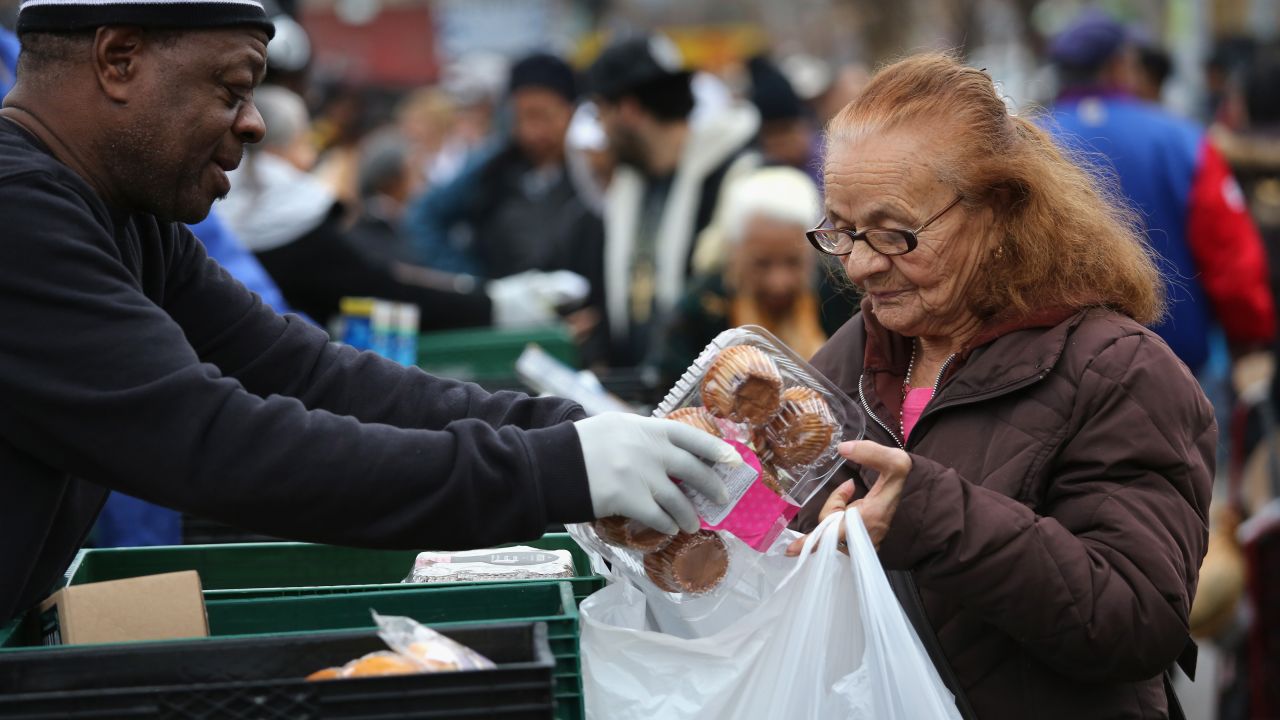
Brooklyn residents receive free food as part of a Bowery Mission outreach program on December 5, 2013 in the Brooklyn borough of New York City. (Photo by John Moore/Getty Images)
This post originally appeared at Talk Poverty.
On Sept. 13 the Census Bureau released new data showing that Americans made historic gains in income, poverty reduction and health insurance. Wonks everywhere predicted good news — but what we saw in the data went well beyond our expectations.
As antipoverty advocates, we’ve become so accustomed to poverty staying stagnant — or getting worse — since the turn of this century that we barely know how to celebrate this kind of progress properly. So, let’s take a minute to appreciate it.
The US poverty rate saw one of the largest single-year declines in almost 50 years. After years of stagnant incomes the typical American household got a raise for the first time in nearly a decade, with median household income rising more in one year than ever recorded. Meanwhile, the share of Americans without health insurance dropped to a record low, making 2015 the first time we’ve seen simultaneous improvements on all three fronts — poverty, median household income and health insurance coverage — since 1999.
The improvements we’re marking this week didn’t happen by accident — they’re the result of policies that work. And with the wrong policy choices, we could see these important gains erased.
Take the minimum wage. State and local minimum wage increases likely played a big role in the decline in poverty and increase in income that we saw in 2015 — as well as the faster wage growth among African-American and Hispanic workers and women (all of whom are disproportionately likely to be low-wage workers). They also likely helped the gender wage gap hit 80 cents for the first time ever, and led to even stronger progress on the wage gap for African-American women. And in states that enacted minimum wage increases, low-wage workers saw faster wage growth than workers in states where minimum wages stayed flat.
On the health insurance front, the Affordable Care Act remains the gift that keeps on giving. The tremendous gains in coverage that we saw in 2014 and 2015 brought the nation to a record low uninsured rate of 9.1 percent. But here too, variation across states demonstrates the difference that policy choices make. The average share of uninsured individuals in states that hadn’t expanded Medicaid by January 2015 was 12.3 percent, compared to just 7.2 percent in states that had adopted Medicaid expansion. It is clear that the national gains would have been even stronger if 19 states weren’t still refusing to expand their Medicaid programs.
And let’s not forget the safety net. Census data released yesterday using the Supplemental Poverty Measure (SPM), an alternative measure that takes into account critical poverty-reducing investments such as nutrition assistance and tax credits for working families, reminds us how important these and other programs are to cutting poverty and mitigating hardship. According to the SPM, without Social Security nearly 27 million more Americans would have been poor in 2015 — that would be an increase of more than 58 percent in the share of poor Americans. The Supplemental Nutrition Assistance Program protected 4.6 million Americans from poverty. And the Earned Income Tax Credit and low-income portion of the Child Tax Credit together accounted for 9.2 million fewer individuals living in poverty last year.
We’ve got to keep moving the needle in the right direction, particularly as we have yet to return to pre-recession levels of poverty and incomes. And despite strong progress on the national poverty rate, poverty among children, female-headed families, African-Americans, Hispanics, Native Americans and people with disabilities remains dramatically higher than the overall national rate.
But the big takeaway from yesterday’s data that we should all be shouting about is that we know we can make great progress in cutting poverty — if we make the right choices. Now is the time to double down on the policies we know make a difference, such as making job-creating investments in infrastructure, research and education; raising the minimum wage and further strengthening tax credits for working families; ensuring paid leave, childcare and fair schedules, as well as closing the gender wage gap; protecting and strengthening vital safety net programs; and removing barriers to employment for people with criminal records and their families, and workers with disabilities.
Today we should all celebrate the progress we are finally making. But tomorrow, we must use this news to inform the work we do together in the months and years ahead. Now is the time to recommit to making the right choices so that we don’t turn back.





